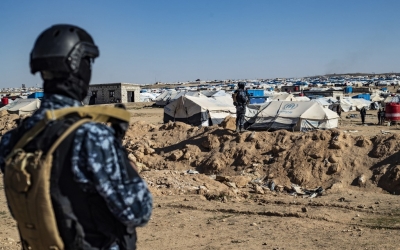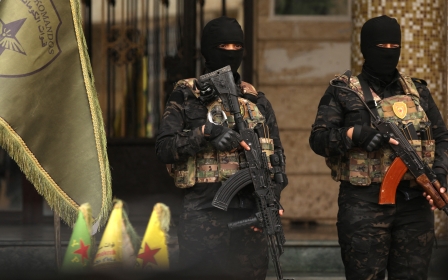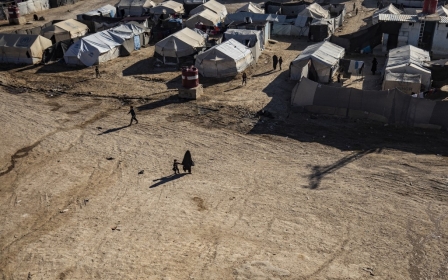'Sabaya': Acclaimed film about Yazidi women rescued from Islamic State is a 'hoax'

An award-winning documentary, Sabaya, portraying the struggle of two men to save Yazidi women from the Islamic State (IS) group, has been accused of having faked scenes and manipulated characters, following an investigation by Swedish online magazine Kvartal.
The director of the film, Hogir Hirori, is accused of intentionally portraying the two Yazidi men as heroes, whereas they had allegedly separated Yazidi women from their children. The report claims the men had also attempted to sell the children to IS, coercing the women into doing things against their will and keeping some under house arrest for two years.
'They didn’t go into the camp to rescue these girls in many cases; they went in and took their children away from them'
– Former US Ambassador Peter Galbraith
The investigation comes over a year after the release of the documentary, which won awards at multiple international festivals, including the director’s prize at the prestigious Sundance Festival, and praise from international media and critics.
Kvartal said it had obtained an incriminating audio recording in which a Yazidi woman can be heard telling Hirori that one of the men who helped them escape from al-Hol, a largely lawless camp run by Kurdish security forces, had treated them “worse than IS did”.
This is not the first time the documentary has been shrouded in controversy. In September, a New York Times article claimed that the women and girls featured in the documentary had not given consent to be filmed. Documents obtained by the paper showed that consent forms were only sent after the film debuted.
New MEE newsletter: Jerusalem Dispatch
Sign up to get the latest insights and analysis on Israel-Palestine, alongside Turkey Unpacked and other MEE newsletters
The documentary was financed “to a significant extent by Swedish taxpayers’ money”, having received financial support from the Swedish Film Institute and been co-produced by Swedish Television (SVT).
‘Real heroes’
The film follows Mahmud and Ziyad, who are presented as Yazidi men risking their lives to save Yazidi women and girls enslaved by IS. The women had been living in the notorious al-Hol camp in northern Syria, which houses 60,000 people believed to be mainly IS supporters and their families.
Mahmud and Ziyad load their guns and barge into tents to find the women and their children and bring them to safety, to a centre the pair run.
"With just a mobile phone and a gun, Mahmud, Ziyad and their group risk their lives to try to rescue Yazidi women and girls held captive by IS," claims the film.
Hirori, who has Kurdish roots, made several trip to Syria and Iraq to film the documentary.
Some Yazidi women, who were kidnapped and used as sex slaves by IS, starting in 2014, have had children as a result of rape.
Even though many sections of the traditional Yazidi community have broadly accepted these children, some have rejected them.
For this reason, many Yazidi women wanted to remain in the camp to be with their children, out of fear that their half-Yazidi children were not going to be accepted.
However, Kvartal reported that Mahmud and Ziyad had tricked many of the women into leaving the camp, by promising them that they will be reunited with their children shortly after.
During the award ceremony at Sundance Festival, Hirori praised the two men for their important work, calling them "real heroes".
New revelations
One of the women "saved" from al-Hol camp told Kvartal that she was "tricked" into thinking her children would be taken care of if the women left the camp.
“We tried to see our children afterwards, but they refused to let us,” said the woman.
Former United States Ambassador Peter Galbraith was working on the ground in Syria and Iraq while the documentary was being filmed. He had played a big role in helping 20 Yazidi women and girls reunite with their children.
One of the reunions was widely reported by international media, but according to the diplomat, none of the publications noted that it was Mahmud and Ziyad who had separated them in the first place.
“The film distorted what [the main characters] were doing. They didn’t go into the camp to rescue these girls in many cases; they went in and took their children away from them,” Galbraith told Kvartal.
The diplomat added that the men's main aim was to protect the honour of the community by getting rid of children born out of rape by IS militants.
The mothers and their children were taken out of al-Hol, he explained, and the latter were then taken to a Kurdish orphanage in north-eastern Syria, which was full of children born to Yazidi women and girls, some of them as young as 10.
“There were some mothers who absolutely refused [to be separated], and they were kept in a kind of house arrest for two years,” Galbraith said.
Children sold to IS
CBC, the Canadian public broadcaster, had previously interviewed Mahmud about his work in rescuing Yazidi women, without being aware of his role in the documentary. In the interview he acknowledges that he had sold children born to the Yazidi women he “saved” as a bargaining chip to IS militants, in exchange for information.
Nechirvan Mando, the fixer and translator who worked with CBC on the report, told Kvartal that it was true that children were offered for sale, but that it was a way to “trick” IS militants.
However, Mando and other sources confirmed that some women were separated from their children by Mahmud and Ziyad, and those who refused to be split up were kept under house arrest at the headquarters of their operation.
“The film was largely based on a lie,” said Galbraith.
Hirori declined to comment on Kvartal's report, telling Swedish TV programme Kulturnyheterna that “there is no evidence for Kvartal's claims" and that "it is impossible for me to comment on loose allegations".
Ziyad also declined requests for comments. Mahmud died last year.
Fake scenes
The investigation also showed that Hirori had faked scenes from the film. A sequence where a woman named Leila was supposedly shown escaping al-Hol camp with the help of the two men, while being chased by IS militants, was actually filmed with another woman.
The dramatic scene has been mentioned in numerous reviews and interviews as one of the strongest sequences. But Leila was released from al-Hol long before Hirori first arrived in Syria to film the documentary. Kvartal has called the most important scene of the documentary a “hoax”.
“I think it damages the credibility of the film," says Axel Arno, programme director at SVT and editor assigned to Sabaya.
One of the women rescued by Mahmud and Ziyad told Kvartal that most of the movie contains “fabricated scenes”, and the nightly raids carried out in al-Hol by Mahmur and Ziyad to save Yazidi women “are not genuine”.
The movie depicts the two entering tents, gun in hand, and searching for people. The Yazidi woman interviewed laughed at the idea that that would be possible and said that people were not allowed to enter the camp without escort by Kurdish forces.
“They couldn't do it. It's true that they helped us, and they did a lot for me," the woman said. "I lived for a month in their house. But in reality, they couldn't enter the camp without Kurdish forces.”
Middle East Eye delivers independent and unrivalled coverage and analysis of the Middle East, North Africa and beyond. To learn more about republishing this content and the associated fees, please fill out this form. More about MEE can be found here.






